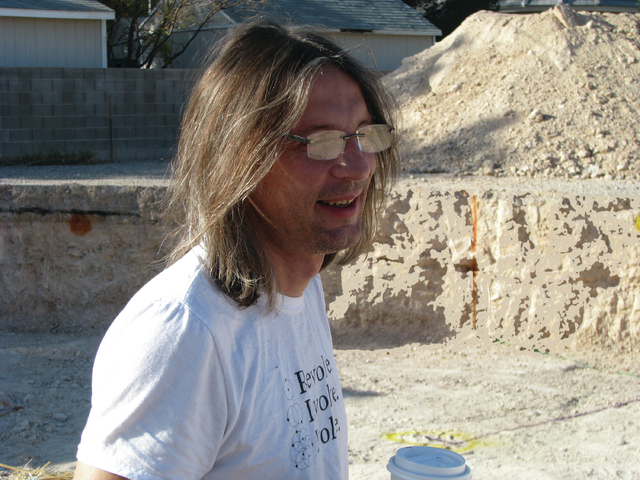Dome-icile: Woman builds dwelling made mostly of soil, straw
The majority of homes in the valley are built primarily of lumber, a nonnative resource. A local woman hopes to start a trend of building homes with a resource the valley has in abundance: dirt.
The typical 2,400-square-foot, single-family home requires about 16,000 board feet of framing lumber and more than 14,000 square feet of other wood products, according to the Idaho Forest Products Commission. That wood needs to be imported here.
That fact inspired Liz Kerby, a health coach and nutritional consultant at the Renaissance Health Centre, 2820 W. Charleston Blvd., and the Institute for Integrative Nutrition, to look into alternative construction materials and techniques for a project planned at 4242 Mountain View Blvd., consisting of seven domes.
“I’ve always been interested in alternative building, particularly straw construction, but a friend’s husband pointed out that we don’t grow any crops that can produce straw here, but we have plenty of dirt,” Kerby said.
Earthen homes are not a new idea but an ancient one that some builders have been trying to resurrect using modern tools, materials and science. The Native Americans built sprawling settlements out of adobe, a mix of native soil, clay, water and fibrous material, often straw. Later, the Spanish settlers followed suit, utilizing the thick walls as insulation, staving off the heat before air conditioning was available. Modern adobe usually consists of a thin, decorative veneer over plywood.
“I have a friend who’s an expert on solar power who is fond of pointing out that we don’t build houses here, we build ovens,” Kerby said. “Then we try to find a way to cool them down.”
While Kerby was visiting a friend in Tecopa, Calif., she met Erik Ven, who builds earthen homes and teaches workshops on their construction. Ven was having a similar home built. She brought Ven to work on her new home and teach workshops here during construction.
“Originally, I built homes using Superadobe, which I studied and taught at Cal-Earth in Hesperia (Calif.),” Ven said. “This home is a combination of Superadobe and Earthship technology.”
Earthship is a Taos, N.M.-based company that builds solar houses made of natural and recycled materials. Cal-Earth is the brainchild of architect Nader Khalili, who had a successful career building high-rise and conventional buildings before becoming interested in ceramic homes and developing Superadobe, a process using native soil and a carefully calibrated amount of cement in long-tube bags. The bags are then coiled into dome structures.
“We had the soil tested, and an engineer determined that we need to add 5 percent of cement here,” Kerby said. “It all gets mixed in a cement mixer and put into the bags by hand.”
Kerby took a tour and a workshop at Cal-Earth, visited the Fenix Dome, a local concrete dome-style home built by Texas-based Monolithic Dome Institute, and spent the night at Arcosanti, an experimental town in central Arizona, before deciding on the current construction.
The design calls for a home partially underground with 21-inch-thick earth and cement walls topped with 10-inch straw insulation, sealed by a waterproof mix made primarily from native soil. The home is slated to be seven domes in a semicircle that can be entered through a greenhouse with southern exposure. The greenhouse would provide solar heat in the winter. The structure is expected to be cooled in the summer with earth tube cooling.
“When you get 6 feet down, the temperature is a steady 58 degrees,” Kerby said. “We’ll use that to cool the home. There will be no electric air conditioning.”
The plan is to have no electrical connection and to run power from solar collectors.
“We’d like to keep the house off the grid if we can,” Kerby said. “The power company wants $9,000 to hook up the power, even though there was power running to the house that was here before.”
Last year, Kerby had no plans to build a home, let alone one that was so unusual.
“I’ve been living in an apartment since I moved back to Las Vegas from Pahrump four years ago,” she said. “I decided I needed another bedroom, but I couldn’t find what I was looking for at the price I wanted.”
While searching for a new place to live, she stumbled across the empty lot with a hand-painted sign reading “For sale by owner.”
“I thought that maybe I should just build that place I want,” Kerby said. “The price on the property was good, so I took the plunge.”
Plans were drawn up a year ago, and ground was broken in September.
“We got together with the neighbors in October to talk about what we’re building,” Kerby said. “We had some people who weren’t happy about it and others who were extremely happy.”
Kerby and Ven have their fingers crossed that city of Las Vegas planners and officials will be pleased with the project.
“We filed all of our permits, applications and plans,” Kerby said. “We got our permit to dig, and we heard back from the planning and zoning. They had one minor change we had to make regarding our setback. We haven’t heard back from the big ones yet.”
Kerby knows she is entering uncharted territory by building the first home of this type in the valley. She’s aware she has a long way to go but hopes she can pave the way for other homes built primarily of local, sustainable materials.
“It’s not a $1 million home,” she said. “I’ve got a budget of $150,000, but you can do these a lot more simply, too. Cal-Earth has pre-engineered plans for single and double domes that are 400 and 800 square feet. I want to build this house so that others can do the same.”
For more information about the project, visit tinyurl.com/oadomes.
Contact East Valley View reporter F. Andrew Taylor at ataylor@viewnews.com or 702-380-4532.

















